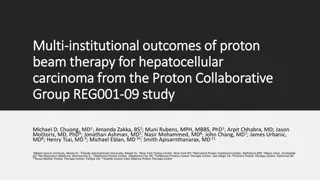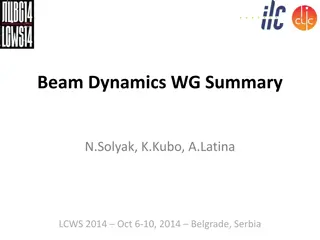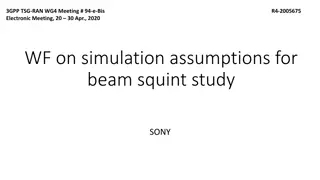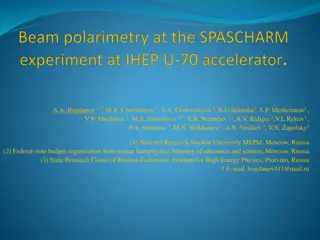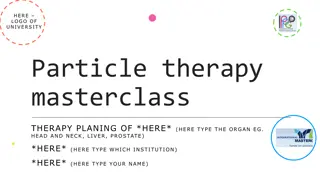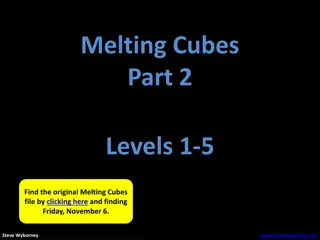Proton Beam Simulation for Melting Snowman in Gundam Analysis
Conducting a proton beam simulation to analyze the feasibility of the beam rifle in Gundam by melting a snowman. The exercise involves setting up geometry, defining parameters, sources, materials, and cells, and calculating energy deposition. Follow the flow chart to determine beam current and power required to melt the snowman. Explore the setup of a snowman with ice balls and an aluminum plate, focusing on materials and structure. Step 1 involves constructing a big ice ball to proceed with the simulation.
Download Presentation

Please find below an Image/Link to download the presentation.
The content on the website is provided AS IS for your information and personal use only. It may not be sold, licensed, or shared on other websites without obtaining consent from the author.If you encounter any issues during the download, it is possible that the publisher has removed the file from their server.
You are allowed to download the files provided on this website for personal or commercial use, subject to the condition that they are used lawfully. All files are the property of their respective owners.
The content on the website is provided AS IS for your information and personal use only. It may not be sold, licensed, or shared on other websites without obtaining consent from the author.
E N D
Presentation Transcript
Melt a snowman by a proton beam Sep. 2021 revised title 1
Purpose of this exercise Let s consider how realistic the beam rifle in Gundam is based on the current accelerator technology by performing proton transport simulation in snowman Lecture on Geometry setup Change of source Concept of normalization Courtesy of D. Satoh at JAEA Purpose 2
snowman.inp Basic setup Projectile Geometry Tally 100-MeV proton (pencil beam with a radius of 1.0 cm) Water sphere of a 5-cm radius at the origin [t-track] fluence distribution [t-deposit] absorbed dose (Gy/source) in water sphere Definition of volume of sphere is necessary at [volume] section x: Serial Num. of Region y: Dose [Gy/source] p: xlin ylog afac(0.8) form(0.9) h: x n n y(all ),l3 n # num reg volume all r.err 1 1 5.2360E+02 2.9777E-11 0.0023 deposit.out 29.777 (pGy/source) track.eps 3 Check Input File
Sections in snowman.inp [Title] Title of the simulation [Parameters] Define history number etc. [Source] Define source [Material] Define materials [Surface] Define surfaces [Cell] Define cells [Volume] Define volume of cells [T-Track] Draw particle trajectory [T-Deposit] Calculate deposition energy II. Source snowman.inp I. Geometry III. Tally (Detector) Sections in Input file 4
Flow chart of this exercise 1. Set geometry of a snowman 2. Set beam condition 3. Determine beam current and power to melt a snowman Procedure 5
Geometry setup of a snowman \phits\utility\rotate3dshow Geometry setup in this exercise Instruction A simple structure with one big and one small ice balls, and an aluminum plate Material of the ice balls is 1-g/cm3water (without temperature option*) The aluminum plate is placed on top of the small ice ball *Temperature option influence only motion of low-energy neutrons 6
Step 1: Construct a big ice ball Set a big ice ball (radius 20 cm, center at z = 0 cm) surrounding the original 10-cm sphere Hint Geometry check can be done with icntl = 8 A spherical surface centering the origin is defined by so radius Define the region of the big ice ball not to overlap the region of the original sphere of 5-cm radius (avoid double defined region) Exclude a newly defined region (big ice ball) from void Check *_geo.out when you encounter an error Step 1 7
Answer 1 Set a big ice ball (radius 20 cm, center at z = 0 cm) surrounding the original 10-cm sphere [ P a r a m e t e r s] Icntl = 8 maxcas maxbch (1) (1) = 2000 = 1 [ C e l l ] 1 1 -1.0 -1 $ Target 2 1 -1.0 -2 +1 $ Big ball 98 0 #1 #2 -999 $ Void 99 -1 999 $ Outer region (3) (3) (4) (4) [ S u r f a c e ] 1 so 5.0 2 so 20.0 999 so 200.0 (1) Geometry check (2) A spherical surface centering the origin (3) Define the region of the big ice ball (4) Exclude a newly defined region (2) (2) Step 1 8
Step 2: Construct a small ice ball Set a small ice ball on top of the big ice ball (radius 15 cm, center at z = -25 cm) Hint A spherical surface centering on z axis is defined by sz center-z-position radius Exclude the region of big ice ball from small ice ball or vise versa, otherwise double defined region is created by two ice balls Step 2 9
Answer 2 Set a small ice ball on top of the big ice ball (radius 15 cm, center at z = -25 cm) [ C e l l ] 1 1 -1.0 -1 $ Target 2 1 -1.0 -2 +1 $ Big ball 3 1 -1.0 -3 +2 $ Small ball 98 0 #1 #2 #3 -999 $ Void 99 -1 999 $ Outer region (2) (2) (3) (3) [ S u r f a c e ] 1 so 5.0 2 so 20.0 3 sz -25.0 15.0 999 so 200.0 (1) (1) (1) A spherical surface centering on z axis (2) Define the region of the small ice ball (avoid double defined region) (3) Exclude the region of big ice ball from small ice ball Step 2 10
Step 3: Set aluminum plate 1. Define aluminum (Al) at [material] section 2. Put an aluminum plate of a 10-cm radius and 4-cm thickness (-40 cm < z < -36 cm) on top of the small ball Hint A cylindrical surface along the z axis is defined by cz radius A plane perpendicular to z axis is defined by pz z-position Density of aluminum is 2.7 g/cm3(negative value for mass density) Exclude region of the aluminum plate from that of the small ice ball Step 3 11
Answer 3 1. 2. Define aluminum (Al) at [material] section Put an aluminum plate on top of the small ball [ M a t e r i a l ] MAT[ 1 ] # Water H 2.0 O 1.0 MAT[ 2 ] # Al Al 1.0 [ C e l l ] 1 1 -1.0 -1 $ Target 2 1 -1.0 -2 +1 $ Big ball 3 1 -1.0 -3 +2 +6 4 2 -2.7 -4 +5 -6 $ Al plate 98 0 #1 #2 #3 #4 -999 $ Void 99 -1 999 $ Outer region (1) (1) (5) (5) $ Small ball (4) (4) [ S u r f a c e ] 1 so 5.0 2 so 20.0 3 sz -25.0 15.0 4 cz 10.0 5 pz -40.0 6 pz -36.0 999 so 200.0 (1) Define aluminum at [material] section (2) A cylindrical surface along the z axis (3) A plane perpendicular to z axis (4) Define the region of aluminum plate (5) Exclude a newly defined region (2) (2) (3) (3) Step 3 12
Step 4: Set proton beam condition Find a proton beam energy so that the absorbed dose at central sphere is maximized Hint Transport calculation can be executed with icntl = 0 Beam energy is given by e0 parameter at [source] section Absorbed dose at central sphere can be checked by deposit.out Proton absorbed dose is maximized at the Bragg peak Step 4 13
Answer 4 Find a proton beam energy so that the absorbed dose at central sphere is maximized [ P a r a m e t e r s ] icntl = 0 (1) Change the icntl parameter (2) Change e0 parameter (3) Check the phits output files track.eps deposit.out (the 27thline) (1) (1) [ S o u r c e ] totfact = 1.0000 s-type = 1 proj = proton e0 = 200.00 r0 = 1.0000 (2) (2) (3) Check the output file Repeating these processes [ S o u r c e ] totfact = 1.0000 s-type = 1 proj = proton e0 = 293.00 r0 = 1.0000 (2) (2) Step 4 14
Step 5: Normalize the result Calculate absorbed dose (Gy) by 1-second irradiation of a 10-nA proton beam, a conventional beam current for proton therapy Hint Default PHITS output is normalized to per particle emitted from source Maxcas and maxbch control only statistical uncertainty, and they have no relation with normalization Set totfact at [source] section to change the normalization factor e.g. Absorbed dose for 100 source particles is given by setting totfact = 100.0 1 A = 1 C / 1 second The electric charge of a proton is 1.6x10-19C Step 5 15
Answer 5 Check the scale change with totfact 1. Number of emitted protons for 1 ampere in 1 second is 1.0 / 1.6E-19 = 6.25E18 (particles) 2. Number of emitted protons for 10 nA in 1 second is 6.25E18 x 10 x 1E-9 = 6.25E10 (particles) Absorbed dose with totfact = 6.25E10 is 1.283 (Gy) (for 293-MeV protons) Answer to Step 5 16
Step 6: Calculate beam current to melt central sphere by 1-second irradiation Assume the snowman is made of ice at -10 C Calculate the proton beam current (A) and the power (MW) necessary to melt the central ice by 1 second 1. 2. Hint (assumption for simplicity) Specific heat of ice is 0.5 (cal/g/K) = 2.1 (J/g/K) Latent heat of ice (heat necessary for phase transition from ice to water) is 333.5 J/g 1Gy = 1 J/kg = 0.001 J/g *Beam power (MW) can be estimated by Particle energy (MeV) Beam current (A) For comparison The maximum power of J-PARC (one of the most powerful accelerators in the world) is approximately 1 MW 17 *In a strict sense, acceleration voltage (MV) x beam current (A)
Answer 6 You can solve the problem by answering the following questions step by step 1. How large is the absorbed dose (J/g) in central sphere by a 293-MeV proton beam with 10 nA in 1 second? 2. How large is the heat (J/g) needed to heat up the ice by 10 K and melt the ice? 3. What current (A) is required to give that heat in 1 second? 4. How large is the power (MW) at this beam current? About 1-MW beam power is required to melt a snowman (Details are given in answer\answer-snowman-en.ppt) Melting a snowman is all we can do with current accelerators (Of course, with longer time, we can melt metals) Beam rifle in Gundam is far beyond current technology ! Answer to Step 6 18
Summary PHITS simulation should be conducted with following order: Construct geometry and tally Define source particles Normalize the tally results Summary 19



